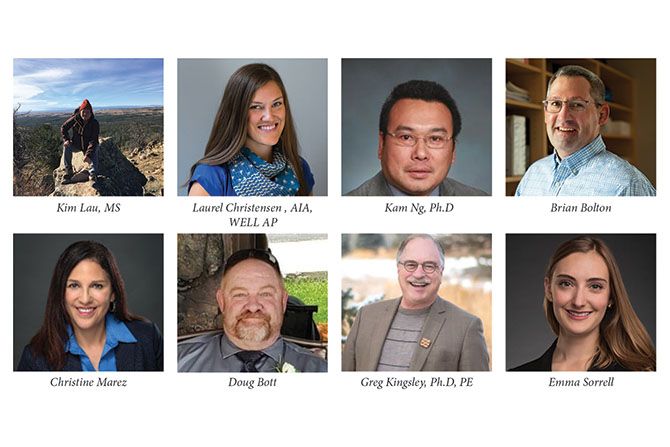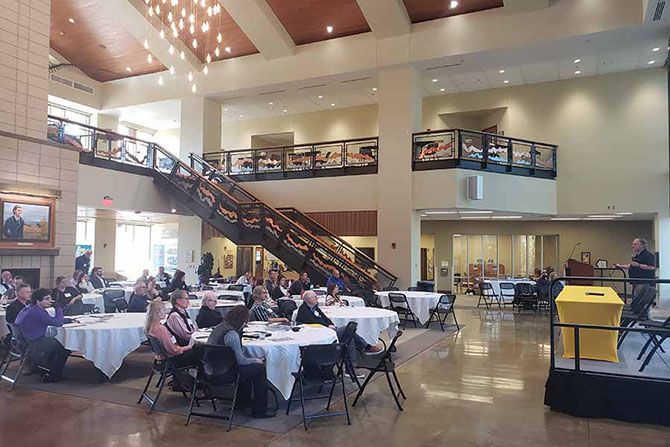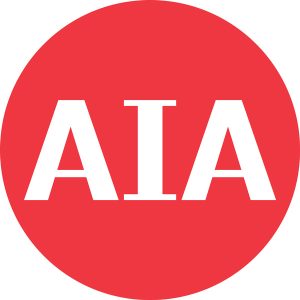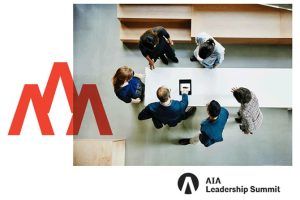
AIA Wyoming hosted its Annual Fall Conference in Sheridan at Sheridan College Oct. 6-8, 2022. The theme and concept of the conference was Green to Green. With the current emphasis on embodied carbon by AIA at the national level, coupled with the volatility in cost and availability of materials, it seemed a comprehensive study of building materials could prove beneficial.
The event explored Wyoming’s architectural practitioner’s role in Architecture 2030’s mission to reduce energy consumption and greenhouse gas emissions in the built environment. We examined how design professionals are advancing the development of sustainable, resilient, and equitable communities while demystifying the cost of sustainability. We discussed aspects of high-performing, sustainable design and construction in the context of what makes practical economic sense for Wyoming and the Rocky Mountain region. As the architecture and construction industry progresses, we continually encounter new environmental and economic pathways, and this conference seeks to provide a snapshot of viable elements that contribute to sustainable design during unsettled economic conditions. Having managed hybrid and virtual presentations over the last few years, an effort was made to offer in-person presentations for the entire conference.
The conference began with a tour of the Mydland Market by Aimee Bolton, AIA. Following this tour, participants were invited to stay for a light meal and a chance to reconnect and network in a more casual setting. The speakers and presentations started the next morning in the Whitney Academic Center of Sheridan College.
Attendees were greeted on Friday morning by the event emcees Jay Nelson of Pella and Scott Reyes of Allegion, two of our annual sponsors.
The first speakers were Kam and Kim from the University of Wyoming. Dr. Kam Ng obtained his B.S., M.S., and Ph.D. degrees in Civil Engineering from Iowa State University and has building consulting and construction experience. He is currently an Associate Professor at the University of Wyoming and a Professional Engineer registered with the State of Wyoming. Kam is currently leading research projects funded by the UW School of Energy Resources and the Department of Energy to develop and manufacture coal-derived building materials.
Kim Lau graduated with her B.Sc. and M.S. degrees in Architectural Engineering from the University of Wyoming. Kim developed coal-derived char bricks and, along with two undergraduate students, manually manufactured more than 4,000 char bricks. A demonstration house has been constructed with these bricks and is being monitored for performance. She is currently a research scientist with the School of Energy Resources at the University of Wyoming.
The following is their presentation description: Pyrolysis char (PC) derived from the Powder River Basin Coal, WY, is one byproduct of an integrated solvent extraction and coal pyrolysis process. This process converts as-mined coal to functional carbon elements. PC is one of the functional carbon elements used in the research development and manufacturing of coal-derived char bricks (CCB). The research development of CCB involves experimental studies using different additives, PC contents and manufacturing procedures to optimize the engineering performance. The engineering performance includes compressive strength, density, thermal conductivity, burning characteristics, and durability. Compared with commercial clay bricks, CCB show advantages in terms of a lighter weight, lower thermal conductivity, and comparable compressive strength. Two demonstration houses were built, one using CCB and another using commercial clay bricks. The performances of these houses are being monitored for temperature, humidity, sound, volatile matters, and gases. Several patents have been filed with the U.S. patent office to attract private investments and facilitate the commercialization of CCB. Physical samples of the bricks used in construction of the two demonstration houses were on hand and made available to attendees for evaluation.
Laurel Christensen was the next speaker. Laurel serves as mindful MATERIALS Director of Outreach and Engagement, where she focuses on building industry partnerships and relationships with Architecture and Design firms, Contractors, and Owners across the built environment. Her experience as a practicing Architect and Sustainable Design Leader at a larder architectural firm and her history of working as a manufacturer’s rep makes her uniquely positioned to understand and communicate the value that mindful MATERIALS brings to the industry.
Laurel explained how as architects, our materials selections have massive impacts, not only on the occupants of the buildings we design but on all those who come into contact with those materials throughout their life cycles. The AIA defines sustainable materials as those that reduce their Impacts on social health and equity, human health, ecosystem health, and climate health, and support a circular economy. Though over 170 A&D firms have publicly committed to evaluating materials across these impact areas, there is still a lack of industry-wide consensus around how building product manufacturers can best document their embodied impacts. Laurel described the mindful MATERIALS Common Materials Framework, which is intended to become a foundation that will allow sustainability and transparency data to become actionable, enabling the future tracking and reporting of holistic embodied impacts of buildings.
AIA Wyoming held its Chapter business meeting prior to lunch with a full agenda of Standing Committee and AIA reports. The Chapter elected the upcoming board of directors positions that will begin on January 1. Brandon Daigle, AIA, will assume his second term as Treasurer, Tim Schenk, AIA, will assume his second term as Director, and members welcomed Mitch Blake, AIA, (not in attendance) to the President-elect position.
At conclusion of the business meeting, Laurel conducted an interactive workshop engaging participants in thought and discussion of the 5 facets which make up the A&D materials pledge developed by AIA. The Architecture & Design Materials Pledge was developed to inspire a shift in how we evaluate the products and finishes that we specify on a daily basis.
Greg Kingsley, Ph.D., PE, followed Laurel. Greg is the president and CEO of KL&A Engineers and Builders in Golden, Colorado, a firm of 110 souls, including structural engineers, civil engineers, land surveyors, steel detailers, steel construction managers, and Team Carbon. They offer Embodied Carbon Impact Reports, Structural Life Cycle Assessment, Embodied Carbon education, material salvage and deconstruction consulting, material stockpile management, concrete mix design consulting and mass timber design.
Greg stated that KL&A recognizes that embodied carbon is part of our industry’s contribution to world greenhouse gas emissions. It is our business to develop new thinking around structural materials and construction: how they are made, how they are used, and how to dispose them. Greg introduced the basic concepts of embodied carbon accounting and portrayed a broad picture of industry trends, opportunities, and strategies for embodied carbon reduction in structural systems. Studies comparing embodied carbon, construction cost and speed of construction on three functionally equivalent buildings in timber, steel and concrete were analyzed. Greg explained that the decarbonization of buildings requires buy-in from a diverse group of participants. Having a better understanding of the priorities and basic needs of each other should foster a stronger, more effective partnership in undertaking this challenge.
Dovetailed into Greg’s presentation was a panel discussion of costs associated with sustainable building by several different professionals. Greg was joined by Christine Marez of the Cumming Group, Brian Bolton of Dick Anderson Construction, Doug Botts of HUB International and Dan Berens of GSG Architecture. Panel members offered their opinion regarding various costs pertaining to sustainable buildings and fielded questions from attendees.
Christine and Emma of the Cumming Group were the final speakers of the day. Cumming is an international project and cost management firm and a nationwide provider of energy, sustainability, and environmental consulting services for existing buildings as well as new construction. They provide a solutions-oriented suite of services that specifically address clients’ unique challenges. Christine Marez is Vice President, and Emma Sorrell is Associate Director of the Cumming Group Energy and Sustainability Team. Their vision is to deliver sustainability and climate solutions in the built environment that improve the quality of life for this and future generations.
Christine and Emma reinforced the concept of embodied carbon, including its significance to the construction industry and impacts on climate change. They introduced EPDs and discussed how to read and apply the information during design, such as setting maximum GWP thresholds in material specifications. They contextualized the growing focus on embodied carbon, including new regulatory mandates, and discussed how embodied carbon interacts with operational carbon in the total carbon of a building. Christine and Emma provided an introduction to sustainability/net zero planning. They described how lower carbon, high-performance buildings provide ongoing operational savings, and the quickening pace of climate change is only accelerating the return on investment. Christine and Emma explained how new collaborations and partnerships can support projects and solutions that create a more valuable, efficient, and resilient built environment and how architects can increase this value by integrating climate action activities throughout their work.
The conference continued Saturday morning with tours by local Architects of the Welcome Market Hall by Dan Stalker, AIA, John C. Schiffer School by Dan Berens, AIA, and the historic Cady Opera House by Levi Van Buggenum, AIA.
We want to thank our sponsors and exhibitors for participating in and supporting our event. Conference sponsors Allegion, Pella and Dick Anderson Construction also participated in the presentations. We also thank our conference planning team, Mark Kucera, AIA, Aimee Bolton, AIA, Dale Buckingham, AIA, Ellen Martin, Assoc. AIA, Ansley Mouw, Assoc. AIA and Susan Menghini, Executive Director, for their efforts in bringing a great event to Sheridan for our members.








